| Article ID | Journal | Published Year | Pages | File Type |
|---|---|---|---|---|
| 8879060 | Field Crops Research | 2018 | 12 Pages |
Abstract
Improved nitrogen (N) management for sorghum production on sandy soils is necessary to maximize N use efficiency, increase yield and mitigate N losses contributing to environmental contamination. A three-year field experiment was conducted on Brunic Arenosols soil in the southwestern region of Poland in a moderate temperate climate to evaluate the effects of varied N fertilization management methods on sweet sorghum hybrid (Sucrosorgo 304) yield and nitrate (NO3â) contents in biomass and bagasse. Sorghum was grown under two levels of N supply - 90 and 180âkg N haâ1, once or split applied as enhanced-efficiency N fertilizer - polymer coated urea and as common N sources - ammonium nitrate and urea. The experimental design included control treatment without N input. Sweet sorghum biomass yields did not significantly differ between N sources. The split application of conventional N sources did not improve sorghum biomass yield. No significant differences were observed in biomass yield averaged across years and N rates in response to the application strategy in the case of all N sources. Highly variable weather conditions during the three sorghum growing seasons resulted in significantly varied biomass yields, ranging from 9.1 to 14.8âMg dry mass haâ1. Nitrate content tended to be higher in biomass within each fertilizer compared with that in bagasse. This study demonstrates that polymer coated urea at the rate of 90âkg N haâ1 provides biomass with a safe level of NO3- and can be recommended in sustainable sweet sorghum production for forage. In addition, in this study an indirect strategy based on Soil Plant Analysis Development (SPAD) readings measured during growing season was proposed to predict NO3- level in biomass at harvest. Results showed that this non-invasive method could provide valuable information on potential NO3â accumulation and animal poisoning risk. However, further research is needed to establish the quantitative relationship between SPAD readings and NO3â level in relation to environmental factors and varied N supply.
Related Topics
Life Sciences
Agricultural and Biological Sciences
Agronomy and Crop Science
Authors
Józef SowiÅski, Lilianna GÅÄ
b,
